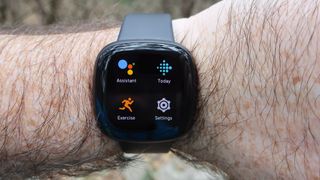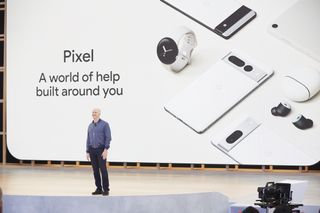Why the Fitbit Sense 2 could cause problems for the Pixel Watch
The Sense 2 and Versa 4 may not have the Wear OS support Fitbit promised, but in hindsight, that's probably for the best.

After a two-year wait, the Fitbit Sense 2 and Versa 4 will ship this September, followed by the long-delayed Pixel Watch in October. All three watches are essentially "Google fitness watches" now: Fitbit is incorporating Google Maps and ditching Fitbit Pay for Google Wallet, and the Pixel Watch will integrate Fitbit tools like Active Zone Minutes and Fitbit Premium.
Note: A previous version of this post mistakenly claimed the Sense 2 and Versa 4 would support Google Assistant. Instead, Fitbit decided to only support Alexa, at least at launch. I apologize for the error.
We don't know yet how much the Pixel Watch will cost, but it's a fair bet it'll cost somewhere between the $280 Galaxy Watch 5 and $400 Apple Watch Series 7. Given the Fitbit Sense 2 will cost $300 and the Versa 4 $230, they'll undercut the Pixel Watch with similar features, iOS, and Android support, and a one-month head start.
Usually a flagship device is supposed to be the whole kit and caboodle, not a compromise.
It's not unheard of for a company to release three similar products at once (see the S22/ Plus/ Ultra or iPhone 13/ Pro/ Max). But even if the Pixel Watch is the "Ultra" watch of the group with better app support and performance, the cheaper Fitbits will very likely be better in areas like sensors and battery life. Usually a flagship device is supposed to be the whole kit and caboodle, not a compromise.
Google may own Fitbit, but it's fair to wonder whether Fitbit's 2022 resurgence and software merge will be to Google's (and Wear OS') detriment.
Fitbit: Poised for a comeback

When Google first announced Wear OS 3 in May 2021, Fitbit CEO James Park said they planned to make "premium smartwatches based on Wear that combine the best of Fitbit's health expertise with Google's ambient computing capabilities." The natural assumption was that its next flagship watch, the Fitbit Sense 2, would run Wear OS instead of Fitbit OS.
But "based on Wear" turned out to be more of a Wear-Fitbit hybrid. It adds some Google apps and "customizable, glanceable tiles" that "create an easier, simpler, and faster way to access the information you care about most."
Be an expert in 5 minutes
Get the latest news from Android Central, your trusted companion in the world of Android
Our original Fitbit Sense reviewer was very underwhelmed with the software experience, calling it sluggish and confusing to navigate. We can hope that the Sense 2 and Versa 4 owners will benefit from these personalized tiles to quickly pull up the fitness data you need, as well as receive a UI speed boost.
The Versa 4 and Sense 2 add a diet-sized influx of Google's computing expertise and apps without needing battery-guzzling RAM or shutting out iPhone users.
Still, even with Google's UI design invading the watch, you won't get the full Wear OS library of apps, just a few Fitbit-compatible apps like Spotify and Starbucks. You'd need a properly powerful chipset to run anything more demanding or in-sync with your phone, and that would cripple the Sense 2's 6-day battery life.
The new Fitbit watches add a diet-sized influx of Google's computing expertise and apps without needing battery-guzzling RAM or shutting out half of Fitbit's userbase on iOS. Fitbit might have originally intended to use Wear OS 3, but 15 months after the system launched, only the Galaxy Watch series and the $1,300 Montblanc Summit 3 have managed to make it work, with other brands still struggling to add it to lifestyle watches with plenty of processing power.
Plus, because they stick to a simpler OS, the Versa 4 and Sense 2 only need one flush button and a touchscreen. The Pixel Watch uses a rotating crown that'll make complex navigation much easier...and will dig into your wrist if you bend it the wrong way during a gym routine.
The Wear-Fitbit hybrid will let the brand release new smartwatches more quickly at a time when they desperately need some sales success, with new tools like Google Maps turn-by-turn navigation to drum up excitement.

Fitbit sold 10.6 million units last year — many of which were likely fitness trackers like the Inspire 2 and Charge 5 — and claimed about 3.6% of the smartwatch market despite not releasing any new watches, as per Counterpoint Research. That put it in the same range as smaller brands like Amazfit and Garmin, and dipped from the 5.7% market share Fitbit had in 2020.
The Fitbit Sense 2 adds a cool Body Response sensor — that is, cool if you want to track your stress levels with continuous electrodermal activity (cEDA), which would only stress me out even more. Otherwise, the new Versa and Sense mainly add a new button...and not much else. It's the promise of Google apps and better performance that'll get people interested in an upgrade, if anything.
So in that sense (sorry), Google's Pixel Watch with Fitbit integration might compete for the same market share of Google fans.
Pixel Watch: Who is it for?
It's impossible to fully judge how the Pixel Watch and Fitbit Sense 2 will compare until Google fully unveils its watch. Leaked info and some informed assumptions can do some of the speculating for us: It will (allegedly) run on an outdated Exynos chipset found in the original Galaxy Watch 1, paired with a massive 2GB of RAM and an industry-average 300mAh battery that'll probably last one full day per charge. And it'll run Wear OS 3 with Material You-style colors integrated into the UI.
Faster (if not groundbreaking) performance, prettier menus, more apps, and the ability to keep your phone unlocked if the watch is nearby, all at a comparable price. In theory, the Pixel Watch sounds like a smart bargain compared to the Fitbit Sense 2, no?

My colleague Andrew Myrick is excited for the Pixel Watch to complete Google's device ecosystem so it can offer interconnectivity similar to what Apple offers. And my other colleague Derrek Lee hopes Google will use the Pixel Watch to more regularly test and push out Wear OS updates, similar to how its Pixel phones promise annual software improvements to all of Android.
In other words, there's a lot riding on this watch with tech bros and gals that see the Pixel Watch as a sign of things to come. If it succeeds, it could be a feather in Google's cap. But its definition of success — or how much smartwatch market share it can claim — is another matter.
The Pixel Watch is attached to the niche Pixel phone series and the controversial Wear OS platform.
Samsung sold 48 million smartwatches in 2021, compared to 162 million Apple Watches (as per IDC). Compare this data to the 272 million Samsung phones and 239 million Apple phones sold that year (per Gartner), and it shows Samsung's users don't buy Wear OS (or Tizen) watches at an especially high rate.
And other Wear OS brands like Fossil (2.2% of all smartwatch sales) aren't particularly widespread either.
Google keeps its Pixel sales numbers pretty hidden, but we know the Pixel 6 outperformed the anemic sales of the 4 and 5, and the Pixel 6a should do much better than the limited-release 5a. So I'd estimate they number somewhere in the low ten millions, not counting older phones like the 3a on their last legs — and the Pixel 7 should add to that number.
If we assume Google has a similar proportion of Pixel users buying a watch as Samsung, its sales would only number in the low millions. Yes, other Android users could buy it, but it won't have the same appeal for Samsung users that can buy that company's own smartwatch instead, or with Android users living where Pixel phones aren't widely used.

Based on the leaked Pixel Watch unit found in a restaurant in April, Google made the Pixel Watch 14mm thick. And trust me, that's thick: compare that to the 10.5mm Galaxy Watch 5 Pro or 11.4mm Sense 2.
We also don't know which Fitbit features will make it onto the Pixel Watch, though I have a wishlist. Obviously the sports modes, sleep tracking, and continuous heart rate will transfer over. But will it get sensors for skin temperature, stress, or on-demand ECG like the Fitbit Sense 2 has? The Galaxy Watch series has a bundle of sensors that tracks everything from blood pressure to body composition; if the Pixel Watch can't match that or the Sense 2 while costing the same, it'll make fitness-focused customers feel like they're missing out.
Choosing the right Google fitness smartwatch
Is the Pixel Watch tempting? Absolutely. If it turns out the way it should, it'll synthesize the best that Fitbit and Google have to offer, with plenty of sensors and a revamped Wear OS experience that makes it more competitive against more well-known brands. I've no doubt it'll be one of the top Android smartwatches available.
But if I can get all the core Google apps and phone notifications on the Versa 4 for cheaper, or more health data and an extra five days of battery life for the same price on the Sense 2, that could be equally tempting.
I look at leaks like this Fitbit app APK teardown revealing that the Pixel Watch will need a 30% charge "to track a full night’s sleep," paired with the news that it'll take 110 minutes to fully recharge the battery, and that you'll have to pay $10/month for Fitbit Premium... and I have to wonder how many fitness fans outside of Pixel lovers will find it compelling. Apple gets away with it, but the Pixel Watch is a more unproven commodity with a less forgiving fanbase than Apple users.
A platform-agnostic Fitbit device that gives you a core Wear OS-lite experience could steal plenty of the Pixel Watch's potential customers, well before it even ships.

Michael is Android Central's resident expert on fitness tech and wearables, with an enthusiast's love of VR tech on the side. After years freelancing for Techradar, Wareable, Windows Central, Digital Trends, and other sites on a variety of tech topics, AC has given him the chance to really dive into the topics he's passionate about. He's also a semi-reformed Apple-to-Android user who loves D&D, Star Wars, and Lord of the Rings.
For wearables, Michael has tested dozens of smartwatches from Garmin, Fitbit, Samsung, Apple, COROS, Polar, Amazfit, and other brands, and will always focus on recommending the best product over the best brand. He's also completed marathons like NYC, SF, Marine Corps, Big Sur, and California International — though he's still trying to break that 4-hour barrier.
